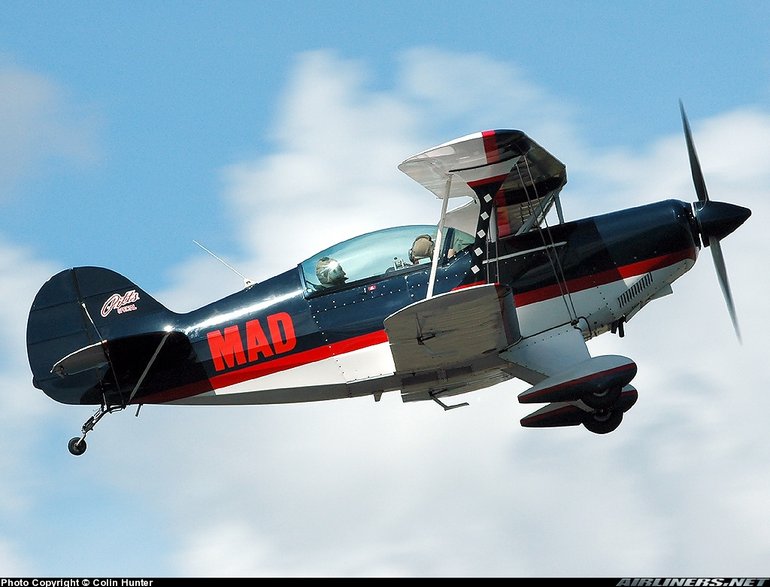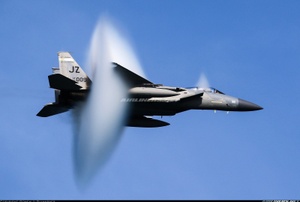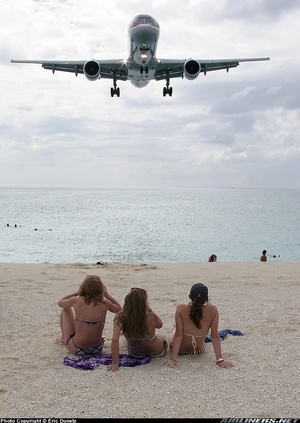Pitts S-1/2 Special
Details
Country of Origin
United States of America
Type
Single and two seat competition aerobatic biplanes
History
The designer of the original Pitts Special aerobatic biplane, Curtiss Pitts, could hardly have appreciated that his design would continue in production for many decades, and that it would come to be considered by the general public for a long time as the definitive aerobatic and display flying aircraft.
The original prototype of the S-1 Special first flew in September 1944. The aircraft was of steel tube construction with fabric covering over wooden spars, while the two wings were braced with wire. Power in early aircraft was supplied by 65 to 95kW (90 to 125hp) four cylinder Continentals or Lycomings. Later models were higher powered and of conventional metal construction.
The early Pitts Special aircraft were custom built, differing in detail and powerplant employed. Examples are e.g. "Little Stinker" built for Betty Skelton in 1947 with a 65kW (90hp) Continental and "Black Beauty" built for Caro Bailey with a 95kW (125hp) Lycoming O-290-D. These models featured two ailerons and flat bottom wings.
The first model for which drawings were available, from 1962, was the S-1C. Like the original S-1, this model had two ailerons and flat bottom wings. The homebuilder could choose between several engines of different horsepower.
A second model for which only plans were available, was the S-1D. This differed from the S-1C in having four ailerons and a slightly longer fuselage.
Factory production (initially by Aerotek) of the basic single seat S-1 Special started with the S-1S with a 135kW (180hp) Lycoming IO-360-B4A, driving a fixed pitch prop, and featuring symmetrical instead of flat bottom wings, with four ailerons. Plans and kits of this version were also available, as the S-1SE (originally named S-1E).
The S-1T was introduced to production in 1981, and introduced a 150kW (200hp) Lycoming (now Textron Lycoming) AEIO-360-A1E driving a constant speed prop and with symmetrical wings with four ailerons. Also the wings were moved forward 11.5cm (4.5in) compared with the S-1S. The S-1T was also available as a kit, as the S-1TE.
The two seat S-2 Special is of the same configuration as the single seat S-1 but is larger overall, and generally regarded as a more capable aerobatic aircraft due to its larger size and heavier weight, more power and aerodynamic changes. For this reason the S-2 is also built in single seat 195kW (260hp) AEIO-540 powered S-2S form (kit version S-2SE), while two seat models are the S-2 with a 135kW (180hp) Lycoming O-360-B4A with fixed pitch propeller (kit version S-2E), the S-2A with a 150kW (200hp) IO-360-A1A with constant speed propeller (kit version S-2AE), and the S-2B with a 195kW (260hp) AEIO-540 engine and with wings and landing gear moved forward 10cm (4in). The S-2B is fully aerobatic with two occupants. The S-2C has aerodynamic changes including square wingtips, fin and tailplanes, flattened belly, refined engine cowl and redesigned windshield. It cruises 24km/h (13kt) faster than the S-2B.
The Pitts Special has been factory built by Aerotek, Christen, and currently Aviat.
Plans and components for the S-1C and S-1SS (S-1S with the aileron technology of the S-1-11B Super Stinker) are currently available from Steen Aero Lab.
Powerplants
S-1S - One 135kW (180hp) Lycoming IO-360 fuel injected flat four piston engine driving a two blade fixed pitch propeller.
S-2C - One 195kW (260hp) Textron Lycoming AEIO-540 flat six, driving a two blade constant speed Hartzell propeller.
Performance
S-1S - Max speed 283km/h (153kt), max cruising speed 227km/h (123kt). Initial rate of climb 2600ft/min. Service ceiling 22,300ft. Max range with no reserves 507km (275nm).
S-2B - Max cruising speed 282km/h (152kt). Initial rate of climb 2700ft/min. Service ceiling 21,000ft. Range with max fuel at economical cruising speed 513km (277nm).
S-2C - Max speed 313km/h (169kt), manoeuvring speed 248km/h (134kt). Initial rate of climb 2900ft/min. Service ceiling 21,000ft. Range at 55% power 555km (300nm).
Weights
S-1S - Empty 326kg (720lb), max takeoff 520kg (1150lb).
S-2B - Empty 520kg (1150lb), max takeoff 737kg (1625lb).
S-2C - Empty 520kg (1150lb), max takeoff 771kg (1700lb).
Dimensions
S-1S - Wing span 5.28m (17ft 4in), length 4.71m (15ft 6in), height 1.91m (6ft 3in). Wing area 9.2m2 (98.5sq ft).
S-2B - Wing span upper 6.10m (20ft 0in), lower 5.79m (19ft 0in), length 5.71m (18ft 9in), height 2.02m (6ft 8in). Wing area 11.6m2 (125.0sq ft).
S-2C - Wing span upper 6.10m (20ft 0in), length 5.41m (17ft 9in), height 2.02m (6ft 8in). Wing area 11.8m2 (127.5sq ft).
Capacity
S-1 series seats pilot only.
S-2 series seats two, except for S-2S which seats pilot only.
Production
Factory built: 64 S-1S, 61 S-1T, 272 S-2 & S-2A, 358 S-2B, 67 (by 2004) S-2C, 17 S-2S.
Homebuilt: 900+
Related Links
Pitts S-1/2 Special
The backbone of this section is from the The
International Directory of Civil Aircraft by Gerard Frawley
and used with permission. To get your own copy of the book
click here.



















